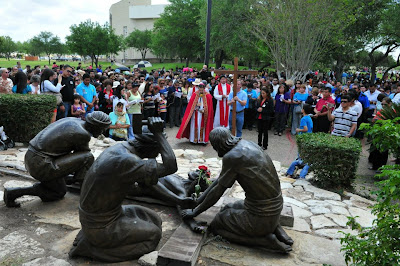The Valley Catholic
SAN JUAN – Walking the Stations of the Cross helps us recall Christ’s final hours. While images of the 14 stations are displayed inside churches and sometimes outdoors in gardens or prayer paths, the life-size statues of the Passion of Christ, which are situated on the grounds of the Basilica of Our Lady of San Juan del Valle-National Shrine, help bring to life Christ’s suffering in an especially dramatic way.
 A traditional Lenten devotion on Fridays and Good Friday, I thought the Stations of the Cross would be an ideal way to start my own Lenten journey on Ash Wednesday.
A traditional Lenten devotion on Fridays and Good Friday, I thought the Stations of the Cross would be an ideal way to start my own Lenten journey on Ash Wednesday.
During my walk, I talked to one pilgrim, Juanita Aguiñaga of Pharr, who plans to attend daily Mass and walk the Via Crucis each of the 40 days of Lent.
Aguiñaga said seeing the images, life-sized, remind her of how much God loves us and how much his Son suffered for our sins. Confronted with his suffering, “It should truly hurt me to offend him,” she said.
 The custom for the Via Crucis originated in the Middle Ages when Christians could not make a pilgrimage to the Holy Land.
The custom for the Via Crucis originated in the Middle Ages when Christians could not make a pilgrimage to the Holy Land. The basilica grounds shaded by mesquites, oaks, elms and palm trees provide a beautiful setting for the Way of the Cross. Benches placed along the way make it convenient to sit in prayer and reflection.
Spending time before each station, gazing on the images, imagining the scene, we can’t help but recognize the tremendous sacrifice that Jesus Christ made as he proceeded on this path in agony and out of obedience to his Father. Station after station he continued no matter the weight of the cross or the suffering he endured, he continued following the will of his Father. Christ’s pain is real.
The sculptor captured it in his face, in his entire body. Barefoot, his face solemn, Jesus carga con su cruz. We see him fall; we see him continue forward. Lou Rodgers, from Boulder, Colo. drew the designs for the statues at the basilica. Italian artist Edmund Rabanser brought the images of the Via Dolorosa to life.
Life-size statues crafted in bronze and resin in aged hues portrays the human form in a size we can visualize. Each scene is set in natural stones to isolate the setting.
The Way of the Cross was a project that took more than five years from initial concept to its dedication in October 1993. It consists of 30 life-size bronze figures located along a path that spans almost one mile.
Rabanser first made a smaller set of the stations (18-inches tall) and worked on them for approximately one year. “I never realized how big this project was,” he said. The Most Rev. John J. Fitzpatrick, bishop of the Diocese of Brownsville at the time, visited the sculptor in to see his work in northern Italy, near the Alps in a town called Ortisei.
It took four and a half years to complete the full set of sculptures for the Stations of the Cross. A master woodcrafter, Rabanser created detailed expressions of each different station. He sculpted each one in order. He said he felt the suffering of Christ as the work proceeded.
Meticulously carved in Italian linden wood, the life-size figures were then reproduced in bronze. He made the crosses from solid oak.
Rabanser, who last visited the Basilica in 2007, to view his work, said he feels a part of them. “I will never make something like this again. Few sculptors have a chance to work on a project like this.”
Thousands of pilgrims come to the Basilica each week, and the Via Dolorosa stands as a permanent invitation to follow Christ’s Passion.
I find the stations where Jesus falls particularly painful, but most painful is the scene in station 11 – Jesus is crucified. He looks to heaven, to his Father; two soldiers hold him down, while another holds a nail in one hand and a hammer in the right. I imagine the nail as our sins and that we hold the hammer.
Walking his last steps, recalling the final hours of our Savior’s pain truly serves as a visual reminder of his love for us and for his Father. Each station provides a different narrative to reflect on and internalize in our own lives.
Pilgrims walk silently along the Via Dolorosa, some leave flowers, sometimes roses. Most often they leave red hibiscus cut from a nearby bush; the flower placed in Christ’s hand or on his crown of thorns.
We finish the fourth station – Christ buried in the tomb. “But the buried Christ,” notes the prayer from the basilica, “is the seed of hope in new life.”
—
Different resources are available for the Stations of the Cross. Copies of the prayers and reflections are available in English and Spanish in the basilica. The U.S. Conference of Catholic Bishops has the stations based on those celebrated by Pope John Paul II on Good Friday 1991 accessible on their website (usccb.org). Also, a variety of apps have been developed for I phones and android phones.
(Originally published in the March 2013 issue of The Valley Catholic newspaper.)

2 comments:
I know I found a very interesting and helpful blog here. I appreciate this wonderful information you have shared with us.
Life Size Statues
Thank you for your kind feedback.
Post a Comment